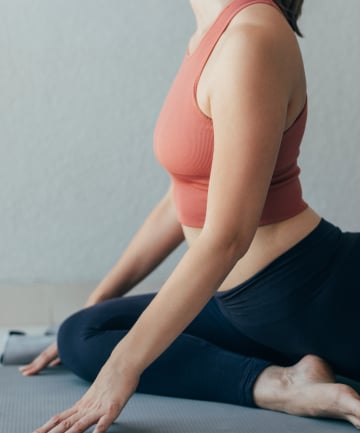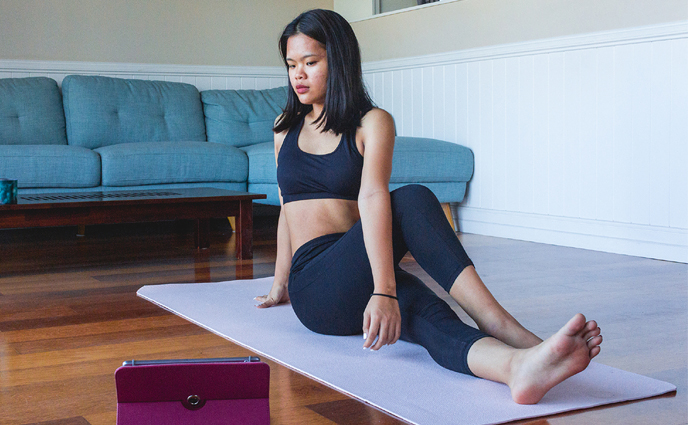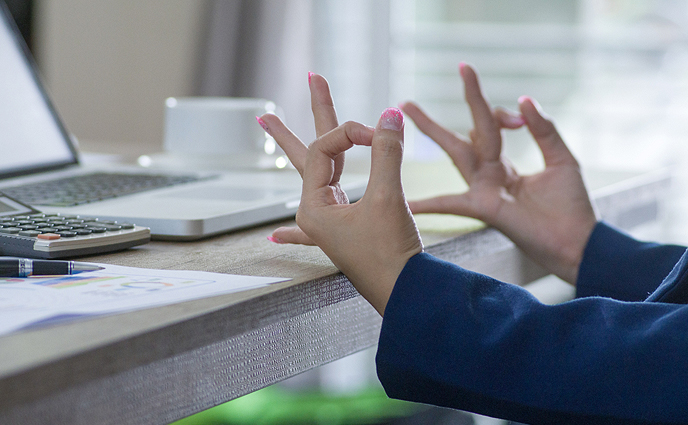Sleeping is another one of those things that varies from person to person, but ultimately your goal should be to feel supported at key places — including your neck and spine — throughout the night.
"While sleeping, the use of a pillow can make a huge contribution to keeping your spine neutral and your body happy," notes Joyce. "If you sleep on your sides, a pillow between the legs will keep your top leg from pulling the lumbar spine out of neutrality. Also hugging a large pillow can help stop the top shoulder from falling forward and pulling the neck with it. If you sleep on your back, a pillow underneath the knees with help to keep tight hip flexors from pulling your lumbar spine into extension."
Also important: your pillow height! Too big or too small and your neck will fall out of alignment and put you at risk to wake up with stiffness. Ultimately, it is important that your pillow allows your cervical spine to stay parallel with the ground.
Image via demaerre/Getty
"While sleeping, the use of a pillow can make a huge contribution to keeping your spine neutral and your body happy," notes Joyce. "If you sleep on your sides, a pillow between the legs will keep your top leg from pulling the lumbar spine out of neutrality. Also hugging a large pillow can help stop the top shoulder from falling forward and pulling the neck with it. If you sleep on your back, a pillow underneath the knees with help to keep tight hip flexors from pulling your lumbar spine into extension."
Also important: your pillow height! Too big or too small and your neck will fall out of alignment and put you at risk to wake up with stiffness. Ultimately, it is important that your pillow allows your cervical spine to stay parallel with the ground.
Image via demaerre/Getty
By understanding what bad posture looks like — and what good posture looks like — you're really already halfway there! Pats on your (upright) back for getting this far. In the next few slides, we're outlining some easy and concrete ways you can improve your posture starting as soon as today.
Image via NanoStockk/Getty
Image via NanoStockk/Getty
"You must reverse the positions that you spend most of your time in," says Joyce. "Many people find it useful to put on a recurring timer that reminds them to get up and move on a regular basis."
For example, if you sit at a desk with your hips flexed and shoulders and arms forward, then take time each day to extend the hips and get your chest opened up with your arms out to the side.
Image via Weeraya Siankulpatanakij/EyeEm/Getty
For example, if you sit at a desk with your hips flexed and shoulders and arms forward, then take time each day to extend the hips and get your chest opened up with your arms out to the side.
Image via Weeraya Siankulpatanakij/EyeEm/Getty
If you've already got a good yoga habit, keep it up! Otherwise, incorporating deep stretching into your workout regimen — yoga or otherwise — is very important for your long-term health and posture.
Joyce says that a deep lunge position is a great anterior hip opener, and that a foam roller placed underneath the spine while you lay down with the arms out to the side will put a great stretch across the chest. He says, "Try to spend a minimum of two minutes in these positions, but of course the longer you spend sitting the more time it will take to counteract."
Yalamanchili also recommends a good pectoral stretch for those who sit in front of a computer throughout the day. "Stand in a doorway or at the corner of two walls. Bend your arms and place forearms against the wall with the elbow at shoulder height. Slowly turn your body away from one arm till you feel a stretch through your chest and shoulder," he advises. Hold the stretch for 20 to 30 seconds and repeat for three reps, then repeat on the other side."
Image via FreshSplash/Getty
Joyce says that a deep lunge position is a great anterior hip opener, and that a foam roller placed underneath the spine while you lay down with the arms out to the side will put a great stretch across the chest. He says, "Try to spend a minimum of two minutes in these positions, but of course the longer you spend sitting the more time it will take to counteract."
Yalamanchili also recommends a good pectoral stretch for those who sit in front of a computer throughout the day. "Stand in a doorway or at the corner of two walls. Bend your arms and place forearms against the wall with the elbow at shoulder height. Slowly turn your body away from one arm till you feel a stretch through your chest and shoulder," he advises. Hold the stretch for 20 to 30 seconds and repeat for three reps, then repeat on the other side."
Image via FreshSplash/Getty
"The most important way to improve your posture — which might not be as obvious — is to exercise. The more that your muscles are primed, the easier it will be in everyday life to use them," says Dr. Shah. "Taking 15 to 20 minutes per day getting your blood moving is a great way to get your muscles primed."
Image via Hinterhaus Productions/Getty
Image via Hinterhaus Productions/Getty









